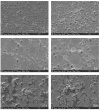Evaluation of Physical-Chemical Properties of Contemporary CAD/CAM Materials with Chromatic Transition "Multicolor"
- PMID: 37297323
- PMCID: PMC10254467
- DOI: 10.3390/ma16114189
Evaluation of Physical-Chemical Properties of Contemporary CAD/CAM Materials with Chromatic Transition "Multicolor"
Abstract
The use of materials for computer-aided design/computer-aided manufacturing (CAD/CAM) has been rapidly increasing in daily practice. However, one of the main issues regarding modern CAD/CAM materials is their aging in the oral environment, which may lead to significant changes in their overall properties. The aim of this study was to compare the flexural strength, water sorption, cross-link density (softening ratio%), surface roughness, and SEM analysis of three modern CAD/CAM "multicolor" composites. Grandio (Grandio disc multicolor-VOCO GmbH, Cuxhaven, Germany), Shofu (Shofu Block HC-Shofu Inc., Kyoto, Japan), and Vita (Vita Enamic multiColor-Vita Zahnfabrik, Bad Sackingen, Germany) were tested in this study. They were prepared in stick-shaped specimens and submitted to different tests after several aging protocols, such as thermocycling and mechanical cycle loading challenge. Further disc-shaped specimens were also created and tested for water sorption, cross-link density, surface roughness, and SEM ultramorphology, before and after storage in an ethanol-based solution. For flexural strength and ultimate tensile strength, Grandio showed the greatest values both at baseline and after aging (p < 0.05). Grandio and Vita Enamic presented the highest modulus of elasticity and the lowest water sorption (p < 0.05). A significant reduction (p < 0.05) in microhardness after ethanol storage (softening ratio%) was observed especially in Shofu. Grandio had the lowest roughness parameters compared to the other tested CAD/CAM materials, while ethanol storage significantly increased the Ra and RSm values in Shofu (p < 0.05). Despite the comparable modulus of elasticity of Vita and Grandio, this latter showed greater flexural strength and ultimate tensile strength both at baseline and after aging. Hence, Grandio and Vita Enamic may be employed for the anterior teeth and for those restorations requiring load-bearing capacity. Conversely, aging seems to affect several properties of Shofu, so its use for permanent restorations should be well-pondered based on the clinical situation.
Keywords: CAD/CAM; SEM; flexural strength; multicolor composites; roughness; ultimate tensile strength; water sorption.
Conflict of interest statement
The authors declare no conflict of interest.
Figures

Similar articles
-
Effects of thermal and mechanical cycling on the mechanical strength and surface properties of dental CAD-CAM restorative materials.J Prosthet Dent. 2022 Jul;128(1):79-88. doi: 10.1016/j.prosdent.2020.11.014. Epub 2021 Feb 2. J Prosthet Dent. 2022. PMID: 33546857
-
Effect of artificial toothbrushing and water storage on the surface roughness and micromechanical properties of tooth-colored CAD-CAM materials.J Prosthet Dent. 2017 Jun;117(6):767-774. doi: 10.1016/j.prosdent.2016.08.034. Epub 2016 Nov 14. J Prosthet Dent. 2017. PMID: 27836147
-
Roughness, surface energy, and superficial damages of CAD/CAM materials after surface treatment.Clin Oral Investig. 2018 Nov;22(8):2787-2797. doi: 10.1007/s00784-018-2365-6. Epub 2018 Feb 5. Clin Oral Investig. 2018. PMID: 29404810
-
Influence of Thermal Cycling on Flexural Properties and Simulated Wear of Computer-aided Design/Computer-aided Manufacturing Resin Composites.Oper Dent. 2017 Jan/Feb;42(1):101-110. doi: 10.2341/16-046-L. Epub 2016 Nov 1. Oper Dent. 2017. PMID: 27802120
-
Aging behavior of high-translucent CAD/CAM resin-based composite blocks.J Mech Behav Biomed Mater. 2021 Mar;115:104269. doi: 10.1016/j.jmbbm.2020.104269. Epub 2020 Dec 13. J Mech Behav Biomed Mater. 2021. PMID: 33341738
Cited by
-
The impact of bleaching using 15% carbamide peroxide on surface properties of CAD-CAM composite structures.Sci Rep. 2025 Jan 28;15(1):3470. doi: 10.1038/s41598-025-88014-3. Sci Rep. 2025. PMID: 39870726 Free PMC article.
-
Mechanical properties of modern restorative "bioactive" dental materials - an in vitro study.Sci Rep. 2025 Jan 28;15(1):3552. doi: 10.1038/s41598-025-86595-7. Sci Rep. 2025. PMID: 39875486 Free PMC article.
References
LinkOut - more resources
Full Text Sources
Research Materials
Miscellaneous

